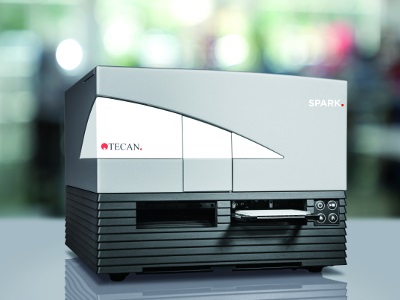Plate Readers
- Update Date:2025-01-15
- Units:Instrumentation Resource Center
[YangMing] Multifunctional Microplate Reader: TECAN SPARK

- Multimode microplate readers
- Brand Model: TECAN SPARK
- Instrument Location: Yang-Ming Campus
- Room 465, 4th floor, Biomedical Engineering Building (H machine)
- Room B02, B1 floor, Shou-ren Building (I machine)
- Room 701, 7th floor, Biomedical Building (J machine)
- Term of Use: Available anytime
- Machine J of the Biomedical Building is open for weekend long-term experiments. Please make online reservations through the "Instrument Reservation System."
- Free of charge for NYCU users. Off-campus users, please contact the center before use.
- Contact center staff:
- Extension:62382
- Email:ycirc@nycu.edu.tw
I.
Instrument Specifications- The system utilizes a high-energy Xenon flash lamp as its light source. This lamp has a notable long lifespan and requires no pre-use warming.
- The flash frequency of the Xenon bulb can be tailored to suit various detection modes.
- Compatible with up to three detectors, the system allows the optimal detector to be chosen based on the detection mode.
- Accommodates sample formats ranging from 6 to 384 microwell plates without changing the Plate Adapter or Plate Holder for different plate sizes.
- Offers continuous full-wavelength screening via a quadruple splitting system, eliminating the need for additional filters.
- Features the Quad4 Monochromator optical system for effective stray light filtration, up to a factor of 10-6, with rapid and precise scanning facilitated by rotating the Monochromator Mirror.
- It provides three oscillation modes: linear, orbital, or double orbital shaking, with 11 amplitude frequency levels (330 rpm to 1440 rpm) adjustable by 0.5 mm increments.
- Allows for direct operation on the panel, including microplate insertion and removal, without requiring a computer.
- Delivers rapid measurement speeds: less than 13 seconds for a 96-well plate and less than 30 seconds for a 384-well plate.
- Includes a built-in power supply.
- Automatically adapts to voltages between 120 and 240 volts.
- Equipped with a USB 2.0 interface for connectivity.
- Features a temperature control range from room temperature +4 to 42℃±0.5℃.
- Designed as a fully modular system, it allows for significant expansion flexibility.
II.
Absorbance Measurement- Independent optical system, dedicated high-speed Monochromator and detector
- Wavelength range: 200 – 1000 nm (UV/VIS/NIR)
- Measurement range: 0 – 4 OD.
- Detector module: UV Silicon photodiode
- Detection accuracy: @260 <0.5 %
- Detection precision: @260 <0.2 %
- Wavelength accuracy: ≦0.8 nm
- Wavelength reproducibility: ≦0.5 nm
- 200-1000nm spectrum scanning speed: ≦5 sec
III.
Full Wavelength Fluorescence Measurement- Measurement mode: Supports upper and lower readings and time-lag fluorescence measurement mode.
- Wavelength range: Excitation range from 230-900nm, while emission range from 280-900nm.
- Adjustable Bandwidth: from 5 – 50nm, with options for 5, 7.5, 10, 15, 20, 25, 30, or 50nm.
- Measurement range: from 0 to 60,000 RFU.
- PMT detector module: Includes independent PMT, UV, and red-sensitive modules.
- Fluorescence magnification Gain value setting: You can choose automatic adjustment (automatic analysis of the entire plate, analysis of specified hole positions, or enhanced dynamic range) or manual setting, and the range of 0~255 can be adjusted arbitrarily.
- Fluorescence sensitivity: The upper reading is 20amol/well, while the lower reading is 0.2 fmol/well.
- Time-lag fluorescence measurement sensitivity: 0.7amol/well.
- Wavelength accuracy: ± 0.5 nm for ≦315nm and >315 nm.
- During the upper reading experiment, the Z-position is automatically adjusted by 1μm to obtain the best fluorescence reading position. This adjustment is based on the difference in liquid level and helps determine the optimal fluorescence signal and background value. A diagram represents the high position.
IV.
Luminescence measurement- Wavelength range: 300-700 nm
- Detector module: Independent Photon Counting System with low dark current PMT, single photon counter, which can accurately detect luminescence readings with weak signals.
- Built-in Attenuation filter, effective detection dynamic range up to 109
- Glow Luminescence detection sensitivity: 225 amol ATP/well,
- Flash Luminescence detection sensitivity: 12 amol ATP/well
- Integration Time/well: 1~20000 ms
- The reading head's height can be adjusted automatically to the optimal Z-position reading height depending on the type of microplates used. This reduces the mutual interference caused by the self-illumination of luminescence samples, thereby improving luminescence detection sensitivity.
- Cross Talk: 0.01%
- Built-in long pass and short pass filters, supporting 19-band multi-color luminescence detection mode
- The software offers an intuitive, wizard-style guided operation interface that significantly improves work efficiency.
- It supports Endpoint, Kinetic, Multilabel, and more experiments.
- All experimental parameters and settings are conveniently displayed in the same window.
- The workflow-oriented software allows users to set the experimental process according to the analysis steps.
- Adding experimental steps is easy using the drop-down options, where users can define the microplate format, the number of readings, settling time, wavelength, and other experimental step settings.
- With the Multiassay function, one microwell plate can support various experiments and calculation parameters.
- The software has built-in enzyme kinetics formulas, and users can choose between Linear or Quadratic slope calculation methods and calculate the area under the curve they selected. The software also has built-in Lineweaver-Burk, Eadie-Hofstee, Hanes, and other drawing formulas for calculating Km and Vmax value formulas.
- One experimental method can be applied to several microplates without any changes.
- The software can read different combinations of filters and match different detection methods simultaneously.
- Users can set cycle parameters, reaction time differences, and specific conditions in the experimental cycle for enzyme kinetics.
- They can also set commands and reminders to be displayed during the experimental steps.
- After completing all measurements, the experimental data will be automatically saved in Excel format.
Related Image(s):












 中文
中文




